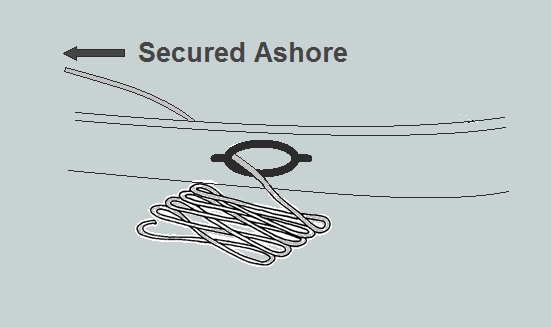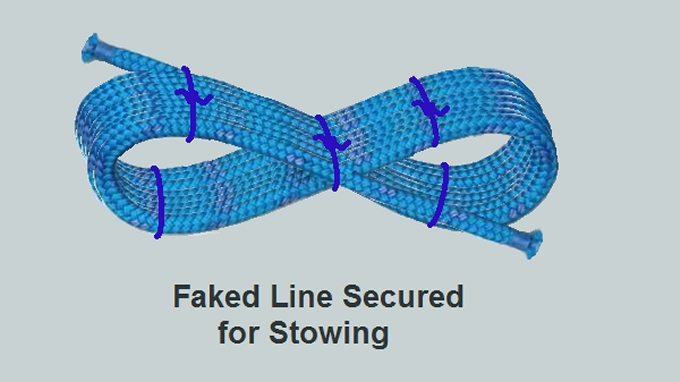The Blue View - Anchoring Techniques: Lines Ashore
/We've encountered perhaps as many as 100 anchorages over the years that were idyllic and protected, but were too small and too deep to anchor safely using the traditional single anchor method. If we dropped the anchor, we either couldn't deploy enough anchor rode or chain to give us our desired scope, or we ran the risk of being on the rocks if and when the tide or wind direction shifted. We've used three methods in these situations, and each has its own advantages and disadvantages.
The first method is to deploy a second bow anchor. This is the easiest method, but our least favorite. Often, the anchorage is too small and too deep to safely deploy two bow anchors. If the anchorage is in an area where the winds and tidal currents shift, we invariably end up with the two anchor rodes twisted around each other, and it always takes time to unwind them. Once we were anchored off Key West for a couple of weeks, and the two rodes were wrapped around each other 15 times. It took us a good hour to unravel them. Not a good situation if we wanted to leave an anchorage in a hurry.
The second method is to use a stern anchor. While the anchorage might still be too small to safely deploy a stern anchor, there are many other situations when using a stern anchor is the best alternative. It has saved our bacon on more than one occasion and has often made a very unpleasant anchorage much more comfortable. This will be the subject of another blog.
The third method is to drop the hook and run lines ashore. We have used this technique in numerous anchorages in Patagonia, Tierra del Fuego, Fiordland and Stewart Island in New Zealand, in some of the Pacific atolls and in Maritime Canada. In fact, we've probably used this method more than the other two combined. We use anywhere between one and four lines ashore depending on the situation, but most often two lines suffice. Sometimes we are so close to shore we need to avoid the tree limbs. Marcie always enjoys picking flowers without leaving the boat.
I briefly discussed this method in my previous blog post “The Blue View – Storms at Anchor”, but I think it is an important enough topic to merit a more detailed discussion. Our shore line “kit” is made up of two, 300' (90m) lengths of 3/4” (18mm) polypropylene line, two 35 pound (16kg) anchors, four 15' (5m) lengths of 3/8” (10mm) chain and several large shackles. We prefer polypropylene line because it floats, so towing it ashore in the dinghy is easier, and it is quite chafe resistant. In the event we need more than two lines, we use one or two of our spare anchor rodes.
The procedure used for running the lines ashore takes a little practice, and varies somewhat depending on the terrain ashore. If the shore has large rocks or trees, we first deploy the dinghy and flake the line out on the aft deck. We pass one end through an aft hawsehole and tie it to the dinghy. Next, we drop the bow anchor and set it, then attempt to back Cups up towards the shore, deploying more chain as needed. When we get as close as we can, I hop into the dinghy and tow the end of the line towards shore while Marcie feeds the line out. I find a place to go ashore and secure the line to a stout tree or large rock. If there is any chance of chafing the line on the rock, I wrap a length of chain around the rock, shackle the ends together, and attach the line to the chain.
If the shore is sandy with no large trees or rocks, I sometimes attach the chain to one of the anchors and go ashore to secure it in place before we anchor. Once we anchor and back up close to shore, it is hard to hold position while I go ashore to secure the stern line, especially if there is an adverse wind or current, so it is helpful to have secured the anchors in advance. If it is a sandy beach, I use a small shovel and bury the anchors as deep as I can. If it is rocky, I try to wedge the anchors in place. Then I return to Nine of Cups and we follow the same procedure for running the lines ashore as before.
The end of the line on Cups is wrapped around a winch, and we use the winch to pull the boat towards shore. If needed, we then run another line to shore from the other side of the boat, and possibly the 3rd and 4th lines from either the midship or bow cleats. By winching in the lines and letting out more chain, we can get the boat quite close to shore, often in some tiny cove that is completely protected. When we are all set, we test the holding by powering away from shore to make sure the lines are secure. The last step is to attach an anchor snubber.
Fortunately, we were alone in the anchorage the first time we tried this. I've left out the part about keeping the dinghy from drifting away as I tried to clamber up, or slipping and falling on those mossy, slippery rocks while dragging two hundred feet of line and carrying 15 feet of chain wrapped around my neck while concurrently swatting at the mosquitoes or flies swarming around my head. It took us well over two hours of sweating and swearing to get everything just right. After a dozen or so times, however, we were completing the task in about 20 minutes and with hardly any cursing at all.
When it is time to leave, I dinghy ashore and release all but one of the lines. Marcie pulls each line aboard while I retrieve and stow the anchors and/or chains in the dinghy. If conditions are anything but ideal, I then dinghy back to Cups, and we motor forward, bringing in the anchor rode while letting out more line astern. If we come to the end of the last shore line, we just cast it off and continue moving away from shore. When we have shortened the anchor rode enough to be sure we won't swing into a tree or any nearby rocks, I dinghy ashore once more and release or retrieve the last line. Usually the anchor is set well enough to hold Cups for these last few minutes even with the reduced scope, but Marcie is there with the engine going just in case the boat does break free.
Keeping all that line tangle free is an art form in and of itself. If we are in an area like Patagonia where running lines ashore is done in many, if not most, anchorages, we mounted spools on the stern rail to hold the lines. I asked a local chandlery to save a couple of empty spools for me. I cut the spools in half, mounted them on the stern rail and used a combination of scrap plywood and lashings to hold the two halves together. They held up well for the season we spent there, but if we were planning to be there longer, I would have done something more permanent. I have also seen cruisers use large plastic laundry hampers or big duffel bags. The line can be faked into the hampers or bags in figure eights after each use. Then when they are needed, it is easy to pull the line out, tangle free. Now that we have only an occasional use for the line, I fake each line in figure eights on the aft deck, then use small line to secure each of the loops. The line is then stowed forward above our chain locker.




